In California’s early days, wherever there were miners, ranchers, loggers, or pioneers, there were places where they went to have a good time. Many of these hangouts—saloons, roadhouses, dance halls, taverns, and hotels—are still going strong. Take a break from the 21st century and go back in time to California’s gilded past at these old-school classics:
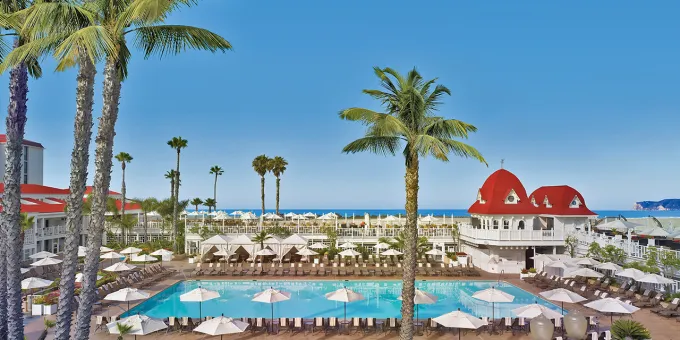
California’s Most Historic Hotels and Inns
Relive the Gilded Age at Hotel del Coronado in San Diego
The 400-room Hotel del Coronado was the world’s largest beach hotel when it opened in 1888. Today the glorious Victorian structure reigns over Coronado Island like an icon of summer nostalgia. Presidents, princes, and Hollywood royalty have swooned over its majestic lobby, domed ceilings, towering cupolas, and swooping chandeliers. Whether you stay for the weekend or just dine at one of its restaurants, a visit here is like a time-warp to the Gilded Age.
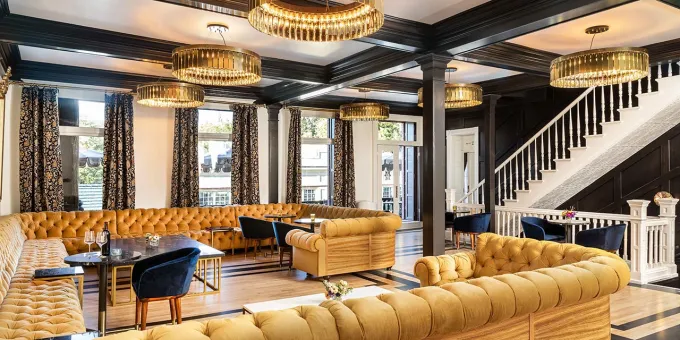
Step into Gold Rush History at the National Exchange Hotel in Nevada City
The National Exchange Hotel is one of the West’s oldest continuously operated hotels, housing Nevada City travelers since 1856. When the stately Victorian was fully renovated in 2018, each Gold Rush–era detail was carefully restored. The Grand Lounge and all 38 guest rooms are decorated with period wallpaper and furnishings, and modern amenities like refrigerators are discreetly tucked away. In keeping with its 19th-century heritage, the hotel has no televisions or elevators, but there’s live music in the bar almost every evening.
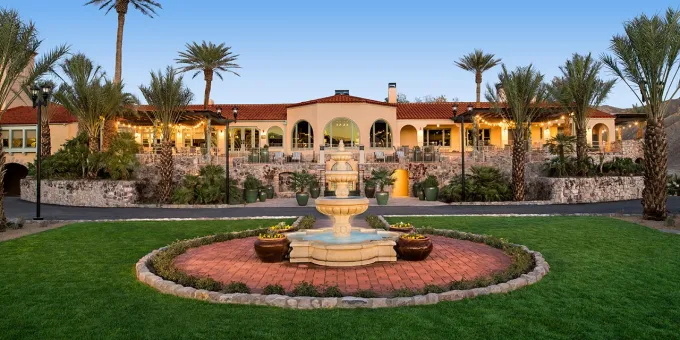
Experience Desert Elegance at The Inn at Death Valley
In 1927, the Pacific Coast Borax Company built an elegant hideaway in Death Valley with hopes of boosting ridership on its struggling railroad. The railway eventually went bust, but The Inn at Death Valley prevailed. The desert oasis still wears the red-tile roof, stucco walls, and graceful archways that enchanted celebrity guests like Marlon Brando, James Cagney, and John Wayne. Today’s visitors can sip cocktails on the stone patio or sun themselves by the spring-fed pool, where the water is a constant 87 degrees.
Discover Hollywood’s Backstories at Chateau Marmont in Los Angeles
You’ll find more celebrity stories at Chateau Marmont than almost anywhere else on L.A.’s Sunset Strip. In 1933, Jean Harlow trysted with Clark Gable here. In 1958, Bette Davis smoked in bed and set the building on fire. The opulent hotel is famous for providing the utmost privacy for its guests. Stay here and strut like a 1940s matinee idol or hide from the paparazzi like a 21st-century rock star.
Experience Riverside’s Iconic Mission Inn
The Mission Inn Hotel and Spa is a spectacular mish-mash of flying buttresses, archways, courtyards, stained-glass windows, bell towers, and antique furniture and artwork. What began as a 12-room boarding house in 1876 soon became Riverside’s first full-service hotel. Expansion projects in the early 1900s resulted in today’s sprawling edifice, which occupies an entire city block. 10 U.S. presidents and dozens of Hollywood stars have signed the guest book at this enchanting hotel.
Spend the Night on the Queen Mary in Long Beach
Starting in 1934, the British ocean liner Queen Mary graced the seas in glamorous Art Deco style. Larger and more luxurious than the Titanic, the ship carried Hollywood elites, royal dignitaries, and, for a time, even World War II troops across the Atlantic until it was retired in 1967. Moored in Long Beach, the ship now serves as a classy 347-room hotel with first-class staterooms decked out in midcentury furnishings. Guests dine like royalty at the ship’s Sunday brunch and enjoy expansive water views from the Observation Bar.
Unwind Victorian-Style in Lake County at the Tallman Hotel
Built in 1874, the Tallman Hotel served as a stagecoach stop for travelers visiting Lake County’s mineral springs. The hotel was rebuilt in the 1890s following a devastating fire, but by the 1960s it fell into disrepair and was abandoned. New owners took over in 2003 and renovated every inch, painstakingly recreating the original building’s Victorian grandeur. A stay here will immerse you in the slowed-down pleasures of a bygone era, like reading on the wraparound porch or listening to music at the next-door Blue Wing Saloon.
Old-School Saloons, Supper Clubs, and Dance Halls
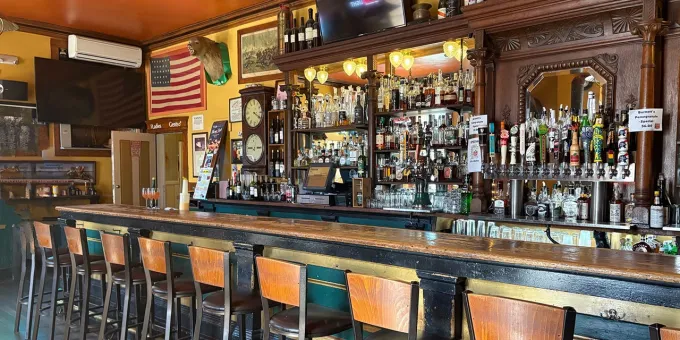
Grab a Pint at the Iron Door Saloon in Groveland
The Iron Door Saloon’s building dates to 1850, but it wasn’t a saloon until 1892, so history buffs debate whether this is really California’s oldest continually operating saloon. Does that matter? Decide as you step through the cast-iron doors, adjust your eyes to the dim light, and take note of the ceiling covered in wadded-up dollar bills. Legend says that miners would stow their cash this way before setting out to search for gold. Add your own greenback to the Groveland staple for good luck, or just order a beer and chat with the bartender.
If you’re fond of 19th-century saloons, also check out the Old Ship Saloon in San Francisco (1851), Heinold’s First and Last Chance Saloon in Oakland (1884), Smiley’s Saloon in Bolinas (1851), Petaluma’s Washoe House (1859), and the Murphys Historic Hotel saloon (1856).
Party Like It’s the Roaring ‘20s at Cicada in Los Angeles
When a jazz or swing band plays beneath the Lalique glass chandeliers, this reservations-only supper club looks like a Titanic movie set. The Cicada Restaurant and Lounge is a place to see and be seen, with some patrons interpreting the “elegant attire” dress code as full-glam Roaring Twenties. Many show up just to dance, but the best way to have the full Prohibition-era experience is to reserve a dinner table, then sip a Mary Pickford while you watch the show.
Need more dancing in your life? In San Francisco, swing dances happen weekly at The Woodchopper’s Ball on the Verdi Club’s 1930s dance floor. In Playa del Rey, Rusty’s Rhythm Club offers beginner classes before swing dance sessions with live music. Sacramento’s Midtown Stomp offers drop-in swing and Lindy Hop classes.
Savor a Steak at The Old Place in the Santa Monica Mountains
The Old Place is where you go when you’re craving an oak-grilled steak in a setting that looks like the Old West. With its weathered-wood façade, low ceilings, and antlers above the door, this steakhouse wouldn’t be out of place in Montana, but it’s just a couple of miles from Malibu in tiny Cornell. The humble building dates to 1909, but the restaurant wasn’t established until 1970. A single detail confirms its historic cred: The kitchen doesn’t have a freezer.
Feast on History at Duarte’s Tavern in Pescadero
Fifty miles south of San Francisco, Duarte’s Tavern is an old-school eatery that never fails to please, whether you’re a local farmer or a city person enjoying a beach day. This 1894 stagecoach stop near Pescadero State Beach has been owned by the same family for more than 130 years. Artichoke soup is the most popular item on the menu, but you’ll also want to taste the crab cioppino and olallieberry pie.
Catch Live Music at the Rio Nido Roadhouse by the Russian River
The Rio Nido Roadhouse has long been a gathering spot for music lovers, with famous names like Bing Crosby, the Beach Boys, and the Grateful Dead performing here since the 1930s. Due to repeated flooding, the roadhouse is now a double-wide trailer with a backyard stage shaded by towering redwoods, but that doesn’t deter the boot-stomping crowd. Weekend shows range from 1940s big band to 1970s reggae, and there are also swing-dance lessons, pool parties, pub fare, and craft beer on tap.
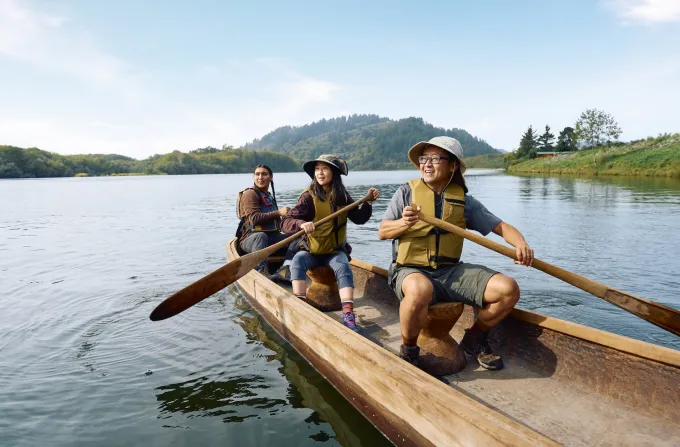
Experience Living History
Canoe the Klamath River in Yurok Country
Head to Yurok Country, where the reservation of the Yurok people, California's largest Native tribe, is located for a guided tour down the Klamath river inside a tremendously rare dugout redwood canoe. Connect with the river on this two-hour excursion inside the handcrafted marvel, one of only three dugout redwood canoes available to the public. Learn about the history of the river, its wildlife, and the Yurok tribe. Tours start at the Yurok Country Visitor Center and are only available in the spring and summer months.
Tour Columbia State Historic Park in Gold Country
The old-timey buildings aren’t show-biz props—Columbia is a real town that doubles as a state park. Take a stroll along cobblestone streets, sip a cold one at the St. Charles Saloon, or browse shops that evoke simpler times: Seven Sisters peddles goat-milk soaps and handmade candles, Columbia Booksellers and Variety Store offers time-traveling novelties, and Ebler’s Leather and Saddle Emporium has the boots, belts, and turquoise jewelry you’ve always wanted.
Ride Mendocino’s Historic Train Through Redwoods and the Mountains
Railroads have played a huge role in California history, and vintage trains still clack along the tracks carrying passengers on excursion rides. Mendocino County’s Skunk Train, an 1880s logging railway, chugs through the redwood forests between Fort Bragg and Willits. The Yosemite Mountain Sugar Pine Railroad operates a steam locomotive in the pine-studded woods near Oakhurst. The “iron horse” at Felton’s Roaring Camp Railroad travels on an old redwood logging route near Santa Cruz. In Sacramento, the California State Railroad Museum displays shiny vintage railway cars and locomotives and runs excursion rides along the Sacramento River.
Climb to the Top of the Point Arena Lighthouse
As ship traffic along the Mendocino coast increased in the mid-1800s, treacherous reefs caused more than 100 shipwrecks. Crews erected a lighthouse, but an earthquake reduced it to rubble. In 1908, a new Point Arena Lighthouse was built, and the 115-foot-tall tower still guards the rocky coast today. Take a peek into maritime history by climbing 145 spiraling steps to the top, then savor expansive coastal views. You can even spend the night in the lighthouse keeper’s cottages.
Set Sail on a Tall Ship in San Diego
Docked at the Maritime Museum of San Diego, the massive schooner Californian is the official tall ship of California. True, it’s a replica and not an actual 1847 shop, but if you want to learn about life at sea during the 19th century, a four-hour cruise will enlighten you about whaling, fur trading, and battles at sea. You can even assist the crew by hauling a line or manning the helm.
Visit Spanish Missions from San Diego to Sonoma
Starting in 1769, Spain built a chain of 21 missions across the length of Alta California as a way of gaining a foothold in the new frontier. The Mission Era ended in 1834—16 years before California became a state—but its legacy endures. Lompoc’s La Purísima Mission is now a state park that hosts living history events and docent demonstrations. Old Mission Santa Barbara gleams with twin bell towers, white-washed adobe walls, a museum of artwork and artifacts, and lush gardens. Mission San Juan Capistrano has guided tours, basket-weaving demonstrations, music concerts, and more.